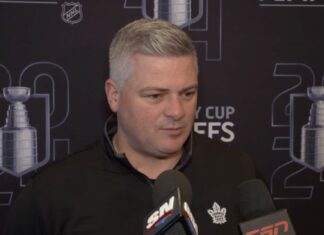
One little note: The terms top 6 and bottom 6 are thrown around rather frequently, but they—re anything but that simple in reality. Lines change often and players move up and down based on recent performance. For the sake of the article, I will be naming the following players top 6 players on the Leafs: Phil Kessel, Clarke MacArthur, Mikhail Grabovski, Nikolai Kulemin, Joffrey Lupul and Tyler Bozak.
The curtain has closed on another disappointing Leaf season without the playoffs. This year had more than its fair share of ups and downs, but the emotional end leaves hope for the future. Goaltending was certainly the biggest change in the second half, with Reimer stepping up after Giguere and Gustavsson tumbled to the floor. But there was another noticeable improvement to the Leafs this season: top 6 scoring. Two players reached 30 goals this year (Phil Kessel, Nikolai Kulemin), improving on last season—s one (Kessel again). This was helped by two further players getting at least 20 goals (Mikhail Grabovski, Clarke MacArthur), again improving over last season—s one (Niklas Hagman). However, there is much more to winning NHL games than scoring some goals. With that said, we—re going to analyze the Leafs— top 6 forwards and see which players rise to the top.
Let—s take a quick look at some basic statistics. Kessel led the team in goals and points for the second consecutive year, amassing 32 goals and 64 points. Grabovski and Kulemin both had their best seasons production-wise, with similar goal and point totals. Kulemin scored 30 goals and 57 points while Grabovski scored 29 goals and 58 points. MacArthur scored far less than these three, scoring only 21 goals, but led the team in assists with 41 and placed second on the team with 62 points. In his short time with the Leafs, Lupul scored 9 goals and 18 points over a 28 game span. If we stretch that out to an 82 game span, it comes out to approximately 26 goals and 53 points. Tyler Bozak was unquestionably the weak link as far as pure offense goes, scoring just 15 goals and 32 points on a line with Kessel. This was a career season for four players in the top 6 and Leafs management is hoping they can build on that even further next year. With that in mind, let—s start diving into some advanced stats.
There are two extremely powerful statistics which should be used at the start of any analysis. They are Quality of Competition (QoC) and Quality of Teammates (QoT). Most useful for players on bad lines teams, QoC and QoT can be extremely helpful in finding players that are perhaps being brought down by the situation they—re in. When the Leafs acquired Kris Versteeg last offseason, I made the argument that Versteeg may have been able to play at a higher level based on his QoC/QoT in a larger role with Toronto. Of course, based on his 53 games, it—s impossible to know for sure what Versteeg—s totals would have been. However, he was on pace for 22 goals and 54 points, a career best.
The three highest QoCs in the Leafs— top 6 were Mikhail Grabovski (0.017), Nikolai Kulemin (0.017) and Joffrey Lupul (0.015). It would make sense that Grabovski and Kulemin would have the highest on the team. Toronto—s third line was somewhat of a revolving door this season and so the team decided to throw out their top line against the top lines from opponents. This makes their successes more impressive than they would seem otherwise. Phil Kessel was the only player in the top 6 with a negative QoC (-0.011), indicating that Ron Wilson was sheltering him somewhat from players that would be dangerous to give the puck away to. This is of course consistent with the somewhat defensively-incapable Kessel we—ve come to know and love.
As far as the quality of teammates is concerned, the top line easily takes the cake for highest rankings. MacArthur (0.433), Kulemin (0.365) and Grabovski (0.286) are all far higher than Bozak (-0.261), Kessel (-0.274) and Lupul (-0.427). For the top line, this indicates their relative stability in staying together as well as Grabovski and Kulemin somewhat making MacArthur a better player. Bozak and Kessel no doubt have low QoT stats due to the carousel that was the left wing on their line. Before Lupul was added to the lineup, the other two were playing with guys like Joey Crabb, Darryl Boyce, Colby Armstrong and Mike Brown. While some of those players may be talented in the roles they—re suited for, it was undoubtedly damaging to the statistics of both Kessel and Bozak. As for Lupul, his stats are heavily skewed by his time in Anaheim this season, where he played exclusively in the bottom 6 upon returning from his back injury. The slow production of the Lupul-Bozak-Kessel line upon his immediate arrival did nothing to help. Just looking at this, it isn—t difficult to see that all three players could produce at a higher level were their line to remain unchanged next season.
Corsi is a relatively basic stat that can be helpful in finding a player—s role on the team. What it measures is a player—s ability to have pucks directed at the opponent—s net (be they on target, goals or missed shots) while comparing it to their inability to keep pucks from being directed at their own net. This produces a rating, which can be shown in both CorsiOn (the team Corsi when a player is on the ice) and CorsiOff (team Corsi when player is on the bench). To the surprise of no one, the CorsiOn/CorsiOff ratios are all best with Grabovski (9.91/-11.44), MacArthur (8.54/-10.78) and Kulemin (4.77/-8.94). Kessel (-6.55/-4.36) and Bozak (-7.12/-4.20) are both subpar, but Lupul (-21.73/-12.49) easily takes the worst ratio. For reference, the CorsiOn for Grabovski leads Leaf forwards, but ranks 44th in the NHL among forwards with at least 50GP. Under the same conditions, Lupul ranks 6th worst in the NHL. Of note is that Todd Marchant and Brandon McMillan, players that Lupul would have played with in Anaheim, rank 4th and 3rd worst in the NHL respectively. Any way you slice it, all three of Kessel, Bozak and Lupul need to find a way to produce more offensive pressure when they—re on the ice.
A plus/minus ranking by itself can be a flawed stat. Without proper context, it can create an unfair picture about a player. Phil Kessel and Tyler Bozak caught a lot of flak this season due to their rather egregious plus/minus rating, which ended at -20 and -29, respectively. This is by no means an all encompassing stat, so let—s take a look at some supplementary details. Using +/-ON/60, the team plus/minus when that player is on the ice per 60 minutes, and +/-OFF/60, the team plus/minus when that player is on the bench per 60 minutes, we can begin to see the clearer picture. Grabovski (+0.80) and Kulemin (+0.60) again lead the way, this time with +/-ON/60, with MacArthur (+0.21) also having a positive plus/minus. For the other line, Lupul (-0.62), Kessel (-0.92) and Bozak (-1.36) again bottom out. This is all consistent with each player—s actual plus/minus.
However, for +/-OFF/60, things become a bit more complicated. The top line players all have negatives in this category, cementing their importance to the team as a whole. Lupul (+0.19) and Bozak (+0.24) have expected totals, but Kessel (+0.09) has managed to be slightly better than Lupul, despite being -20 on the year to Lupul—s -7. It—s not difficult to surmise the reason. Kessel contributes a lot of offense, while the bottom 6 lacks almost any offense whatsoever. Going a bit further, let—s take a look at the team save percentage when Bozak and Kessel are on the ice, as they were the two worst plus/minuses on the team. The save percentage of all goalies on the Leafs at even strength when Bozak and Kessel were on the ice was .904% and .906%, the two worst in the top 6. This is the real culprit in the horrendous stat line for both players. This low percentage indicates that the competition is getting higher quality shots when these two players are on the ice. For Kessel, it—s not difficult to see why. His commitment to defense is inconsistent and he often pinches, as many offense-first players do. For Bozak, the problem may lie in the added responsibility of being a center in the defensive zone. This is less worrying, as it just indicates that Bozak is still in the learning stage of his young NHL career. Regardless, it—s now easier to understand how their poor stats came about.
Before finishing up, let—s take a quick look at zone starts. This is a simple stat which tracks where a player starts a shift and where a player finishes a shift, measured in offensive zone percentage (Ozone% and FinOzone%). Tyler Bozak led the top 6 in Ozone% with 52.4%. Kessel (51.3%), Kulemin (51%) and Grabovski (50.2%) also had Ozone% over 50. Clarke MacArthur (49.5%) and Joffrey Lupul (47.7%) had the lowest percentages, speaking to the faith the coaching staff has in them getting the puck out of the defensive zone and into the offensive zone. Both Bozak (49.5%) and Kessel (50.6%) have lower finishing percentages than starting percentages, again indicating their inability to gain the offensive zone and stay there, even though the majority of their shifts start in the offensive zone. On the opposite side of the coin are Kulemin (53.5%), Grabovski (53.4%), MacArthur (51.9%) and Lupul (50.2%).
That was a somewhat longwinded but rather complete look at the statistics of both the offensive and defensive aspects to the Leafs— top 6. Before signing off, it would probably be best to share my thoughts on their future with the Leafs. Kessel led the team in shots (325) and had stretches where he was dominant. He—ll be a centerpiece on this team for a long time. Grabovski (239 shots) and Kulemin (48 blocked shots) are the real deal, with Grabovski being pretty dynamic and Kulemin easily being the hardest worker on the team. MacArthur certainly surprised a lot of people, myself included, but if I had to pick someone to regress next season, it would be him. That said, he still had a fantastic season while averaging the fewest minutes of any top 6 forward on the team (17:06). For Lupul the most important thing is to what degree he can recapture his previous scoring prowess. If his back continues to haunt him and he becomes a shadow of his former self, I still think he—d fit in nicely as a third line player. As for Tyler Bozak, I think he could fit in rather nicely as a third line center. The defense is by no means perfect yet, but he—s fast and smart. His faceoff percentage is quite good, especially at home where it is 58.61%. Playing on a line with Colby Armstrong next year if the Leafs find a new center for Kessel would help Bozak immensely. With a few pieces, this top 6 could be dominant.




![Sheldon Keefe Post Game, Leafs 3 vs. Bruins 2: “I loved [the Matthews] line, and I loved a lot about our game all the way through the lineup” Sheldon Keefe, Toronto Maple Leafs post game](https://mapleleafshotstove.com/wp-content/uploads/2024/04/keefe-pg-game-1-218x150.jpg)




























![Sheldon Keefe Post Game, Leafs 3 vs. Bruins 2: “I loved [the Matthews] line, and I loved a lot about our game all the way through the lineup” Sheldon Keefe, Toronto Maple Leafs post game](https://mapleleafshotstove.com/wp-content/uploads/2024/04/keefe-pg-game-1-100x70.jpg)



